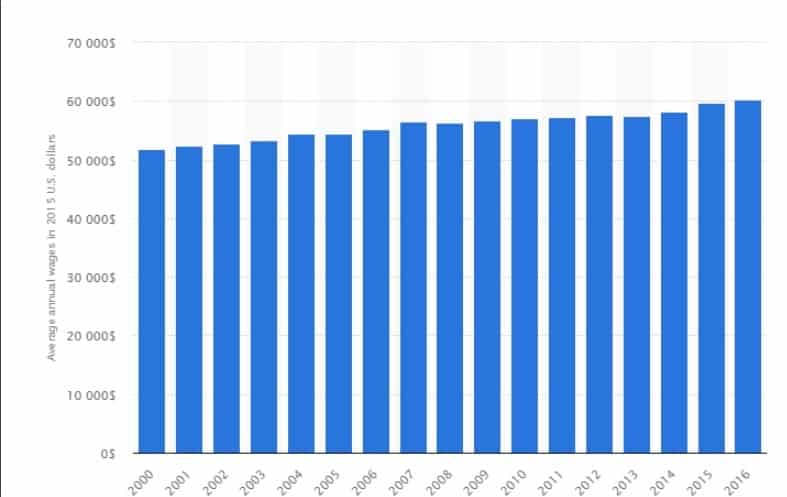Why the huge number of immigrants for over 200 years choose US as your new residence? What makes immigrants from Europe, Asia and Latin America to break away from populated places and move to another continent? Often, sadly, people have to make such a decisive step for economic reasons. Of course, there are exceptions — romanticists, who met their other half in the United States. Scientists and students who received grants in the best universities, too, are moving to the birthplace of modern democracy. However, this is only a drop in the bottomless sea of people arriving daily in the United States for permanent residence.
The most important for immigrants has always been and will be issues related to the work in America and the level of economic development. In this respect, in the US everything is good. Indicators are steadily increasing, and with them rises the average wage in the country.
Here is an example:
Statistics of wage growth in the U.S. over the period 2000-2016.

- In 2000, the average income of a resident of the United States was $51 877, and in 2016-m — already $60 154, that is, the equal increase of 15.96%.
- Moreover, growth stable, and it is likely that in 2019, the average salary of an American is at least $63-65 thousand
- The drop in the unemployment rate and wage growth
In August 2018, the U.S. Department of labor has published a new, encouraging information. According to the latest reports, which you can see here, in July, the unemployment rate fell to 3.9%. These low figures recorded only the eighth time since 1970, and three of them were registered in 2018.
Here is a list of the five major achievements for July of 2018, according to Bureau of statistics of the U.S. Department of labor:
- November 2016 was created 3.9 million new jobs, including 157 thousand new jobs in July;
- the unemployment rate among the Hispanic population of the US rests on a new record level for the second consecutive month, accounting for only 4.5%;
- the unemployment rate among workers with only diploma of high school, is the lowest in history;
- from November 2016 in the commodity industries was established 932 thousand new jobs, including 431 million in construction and 412 thousand in production;
- a record number of Americans (156 million people) have a permanent job.
The unemployment rate among adult men and 3.4% of adult women and 3.7%, adolescents — 13.1%, respectively. The number of Americans who do not have permanent jobs has decreased in comparison with June on 287 thousand and amounted to 1.8 million people across the country.
Less encouraging is the situation in July, for Americans who do not have permanent job for more than 27 weeks (long-term unemployment). Their number has remained virtually unchanged at 1.4 million people (22.7% of the unemployed).
In July, increased the number of people employed in:
- professional and business services (+51 thousand people);
- the computer systems design and related services (+8 thousand);
- the manufacturing (+37 thousand);
- the production of transport equipment (+13 million), machinery (+6 thousand) and electronic instruments (+2 thousand);
- health care and social assistance (+34 million);
- construction (+19 thousand).
- The average income per hour increased by $0,07 to $27,05. The increase for the year was $0.71 in (2.7 per cent).
What does this mean for residents of the United States
On the one hand, indicators of a great and talk about a stable improvement of the economic situation in the country, and thus raising the standard of living for each of us. It is clear to all. On the other hand, why should we worry about the drop in the unemployment rate by 0.1%? What’s wrong with that?
It’s all about the statistics. The last time the unemployment rate reached 3.9% 18 years ago (not counting the drop in unemployment to the same rate in may of this year). In 2000, the unemployment rate stayed at 3.9% for 4 consecutive months. These figures can not be good news, given that earlier the US government was able to demonstrate such a low percentage of the unemployed in January 1970. However, at that time, the labour market differed significantly from the modern one.
What could be the consequences? The most optimistic. If the trend of falling unemployment will remain at least at this level, it is likely that the increase in wages is more substantial than in the past 18 years! The market is in a stable phase, the number of unemployed Americans is reduced, accordingly, there is increasing competition for skilled workers, and hence, and increase of salaries.
In addition, statistics show that people without work for an extended period, do not hurry to go to existing jobs. Most likely, this trend will be able to reverse only even larger decline in unemployment rate together with the predicted income growth.
Theoretically, the reduction in unemployment can partly be explained by the decrease in the labour force last month. However, the unemployment rate in July 2018, has reached a record low in the history of the United States. Focusing on the experience of previous years, likely 2 scenario.
In the first, the Corporation may suspend the hiring of workers, then unemployment will stop falling. In the second, a low percentage of the unemployed will create the best for the last 18 years, conditions in the labour market for job seekers that will lead to the creation of a highly competitive environment, as it was in the early 2000s.